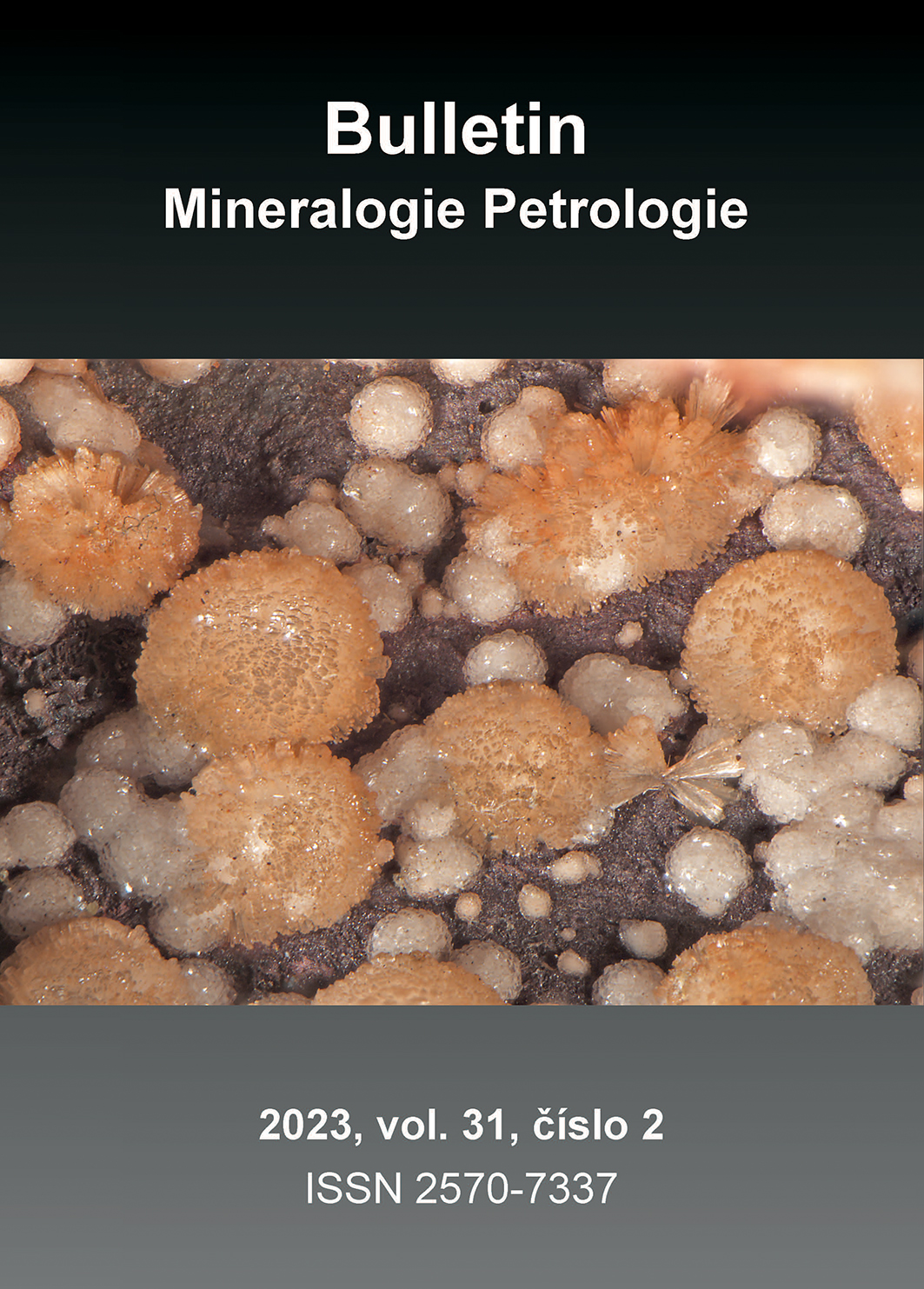Vanadium-, nickel-, and lead-rich phyllosilicates from U-Ni-Co-As-Ag/Bi deposit Zálesí near Javorník
Keywords
Abstract
Two types of phyllosilicates showing different paragenetic position and chemical composition are described from dump ore samples of the Zálesí deposit. The first type is represented by a vanadium-rich (1.1 to 11.7 wt. % V2O3) mica-like phase with chemical composition close to K-depleted (alumino)celadonite, whose aggregates are enclosed in the oldest parts of the uraninite aggregates. Therefore this phyllosilicate belongs genetically to the oldest uraninite mineralization stage. Another type of phyllosilicate is formed by trioctahedral chlorite containing admixtures of mica (perhaps celadonite) and/or smectite. The chemical composition of this second phyllosilicate is very complex, showing in addition to common constituents (i.e., Si, Al, Fe, Mg, Mn, Ca, K) also elevated to high contents of Ni (1.9 - 8.1 wt. % NiO), Pb (2.3 - 10.6 wt. % PbO), Co (0.8 - 2.3 wt. % CoO), Zn (0.4 - 1.0 wt. % ZnO), Cu (0.2 - 1.7 wt. % CuO) and NH3 [0.2 - 1.1 wt. % (NH4)2O]. This phyllosilicate together with calcite and segnitite fills up the “desiccation” cracks in uraninite as well as veinlets cutting gangue minerals, which clearly indicates its genetic pertinence to younger (i.e., arsenide or sulphide) mineralization stages of the Zálesí deposit. The chemical composition of chlorite is in accordance with published formation temperatures of ore mineralization of the Zálesí deposit (<50 to 130 °C). Both studied phases belong to the chemically most complex phyllosilicates if compared with those from other uranium deposits of the Bohemian massif.
Files
References
Cathelineau M (1988) Cation site occupancy in chlorites and illites as a function of temperature. Clay Miner 23: 471-485
Dolníček Z, Fojt B, Prochaska W, Kučera J, Sulovský P (2009) Origin of the Zálesí U-Ni-Co-As-Ag/Bi deposit, Bohemian Massif, Czech Republic: fluid inclusion and stable isotope constraints. Miner Deposita 44: 81-97
Dolníček Z, René M, Hermannová S, Prochaska W (2014) Origin of the Okrouhlá Radouň episyenite-hosted uranium deposit, Bohemian Massif, Czech Republic: fluid inclusion and stable isotope constraints. Miner Deposita 49: 409-425
Fleet ME (2003) Sheet silicates: Micas. Rock-forming minerals, Vol. 3A, 2nd ed. The Geological Society. London
Fojt B, Dolníček Z, Kopa D, Sulovský P, Škoda R (2005) Paragenetická charakteristika hypogenních minerálních asociací uranového ložiska Zálesí u Javorníku ve Slezsku. Acta Mus Silesiae (A) 54: 223-280
Jozja N, Baillif P, Touray J-C, Muller F, Clinard C (2006) Incidence of lead uptake on the microstructure of a (Mg, Ca)-bearing bentonite (Prrenjas, Albania). Eur J Mineral 18: 361-368
Litochleb J, Sejkora J, Šrein V, Klaudy S, Cílek V, Žák K (2009) Hydrotermální alterace a mineralizace uranového ložiska Nahošín jz. od Blatné, Česká republika. Bull mineral-petrol Odd Nár muz Praha 17: 1-22
Melka K, Šťastný M (2014) Encyklopedický přehled jílových a příbuzných minerálů. Academia. Praha
Ondruš P, Hyršl J (1989) New finds and revision of secondary minerals from Příbram district. Acta Univ Carol Geol 1989: 521-533
Ondruš P, Veselovský F, Gabašová A, Hloušek J, Šrein V, Vavřín I, Skála R, Sejkora J, Drábek M (2003) Primary minerals of the Jáchymov ore district. J Czech Geol Soc 48: 19-148
Pauliš P, Babka K, Sejkora J, Škácha P (2016) Uranové minerály ČR a jejich nejvýznamnější naleziště. Kuttna, Kutná Hora
Pauliš P, Kopecký S, Ďuďa R (2008) Minerály selenu a telluru České a Slovenské republiky a jejich lokality - 2. část. Kuttna, Kutná Hora
Pouchou J L, Pichoir F (1985) “PAP” (φρZ) procedure for improved quantitative microanalysis. In: Microbeam Analysis (Armstrong JT, ed.). San Francisco Press, San Francisco: 104-106
René M, Dolníček Z (2017) Uraninite, coffinite and brannerite from shear-zone hosted uranium deposits of the Bohemian Massif (Central European Variscan Belt). Minerals 7, Article No. 50. DOI: 10.3390/min7040050
Sejkora J (1994) Uranové ložisko Zálesí v Rychlebských horách. Bull mineral-petrol Odd Nár Muz Praha 2: 105-110
Sejkora J, Macek I, Škácha P, Pauliš P, Plášil J, Toegel V (2014) Výskyt asociace Hg a Tl selenidů na opuštěném uranovém ložisku Zálesí v Rychlebských horách (Česká republika). Bull mineral-petrol Odd Nár Muz Praha 22: 333-345
Sejkora J, Makovicky E, Topa D, Putz H, Zagler G, Plášil J (2011) Litochlebite, Ag2PbBi4Se8, a new mineral species from Zálesí, Czech Republic: description and crystal-structure determination. Can Mineral 49: 639-650
Sejkora J, Plášil J, Litochleb J, Škácha P, Pavlíček R (2012) Asociace selenidů s makroskopickým umangitem z opuštěného uranového ložiska Zálesí v Rychlebských horách (Česká republika). Bull mineral-petrol Odd Nár Muz Praha 20: 187-196
Sejkora J, Škoda R, Pauliš P (2006) Selenium mineralization of the uranium deposit Zálesí, Rychlebské Hory Mts., Czech Republic. Mineral Polon - Spec Pap 28: 196-198
Škácha P, Goliáš V, Sejkora J, Plášil J, Strnad L, Škoda R, Ježek J (2009) Hydrothermal uranium-base metal mineralization of the Jánská vein, Březové Hory, Příbram, Czech Republic: lead isotopes and chemical dating of uraninite. J Geosci 54: 1-13
